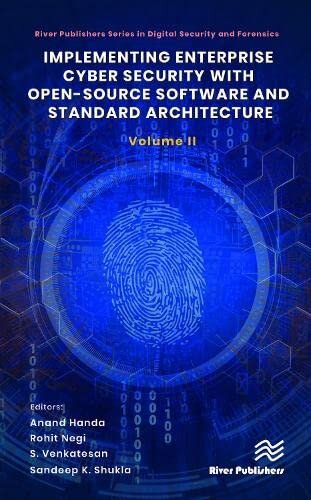

Most ebook files are in PDF format, so you can easily read them using various software such as Foxit Reader or directly on the Google Chrome browser.
Some ebook files are released by publishers in other formats such as .awz, .mobi, .epub, .fb2, etc. You may need to install specific software to read these formats on mobile/PC, such as Calibre.
Please read the tutorial at this link: https://ebookbell.com/faq
We offer FREE conversion to the popular formats you request; however, this may take some time. Therefore, right after payment, please email us, and we will try to provide the service as quickly as possible.
For some exceptional file formats or broken links (if any), please refrain from opening any disputes. Instead, email us first, and we will try to assist within a maximum of 6 hours.
EbookBell Team

5.0
58 reviewsCyber security is one of the most critical problems faced by enterprises, government organizations, education institutes, small and medium scale businesses, and medical institutions today. Creating a cyber security posture through proper cyber security architecture, deployment of cyber defense tools, and building a security operation center are critical for all such organizations given the preponderance of cyber threats. However, cyber defense tools are expensive, and many small and medium-scale business houses cannot procure these tools within their budgets. Even those business houses that manage to procure them cannot use them effectively because of the lack of human resources and the knowledge of the standard enterprise security architecture. In 2020, the C3i Center at the Indian Institute of Technology Kanpur developed a professional certification course where IT professionals from various organizations go through rigorous six-month long training in cyber defense. During their training, groups within the cohort collaborate on team projects to develop cybersecurity solutions for problems such as malware analysis, threat intelligence collection, endpoint detection and protection, network intrusion detection, developing security incidents, event management systems, etc. All these projects leverage open-source tools, and code from various sources, and hence can be also constructed by others if the recipe to construct such tools is known. It is therefore beneficial if we put these recipes out in the form of book chapters such that small and medium scale businesses can create these tools based on open-source components, easily following the content of the chapters. In 2021, we published the first volume of this series based on the projects done by cohort 1 of the course. This volume, second in the series has new recipes and tool development expertise based on the projects done by cohort 3 of this training program. This volume consists of nine chapters that describe experience and know-how of projects in malware analysis, web application security, intrusion detection system, and honeypot in sufficient detail so they can be recreated by anyone looking to develop home grown solutions to defend themselves from cyber-attacks.